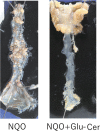Inhibitory Effects of Glucosylceramide on Tumorigenesis Induced by a Carcinogen in Mice
- PMID: 31808958
- PMCID: PMC7687097
- DOI: 10.1002/lary.28449
Inhibitory Effects of Glucosylceramide on Tumorigenesis Induced by a Carcinogen in Mice
Abstract
Objective: Glucosylceramide (Glu-Cer), a glycosylated form of ceramide, has been reported to have cytotoxic effects in the cells of various cancers. We previously reported that dietary Glu-Cer from rice bran had inhibitory effects on human head and neck squamous cell carcinoma (HNSCC) in nonobese diabetes (NOD)/severe combined immunodeficiency (SCID) mice. In HNSCC, preventing recurrence and second primary cancer is required to improve prognosis. The purpose of the present study was to determine whether dietary Glu-Cer had anticarcinogenic and antitumorigenic effects in a mouse model of HNSCC.
Methods: A total of 40 CB6F1-Tg rasH2@Jcl mice were divided into two groups: control and Glu-Cer. All mice were given 4-nitroquinoline 1-oxide for 24 weeks. Control group mice were fed the normal diet without Glu-Cer. The Glu-Cer group mice were given a mixture of the normal diet plus 0.25% Glu-Cer for 24 weeks. Microscopic examination was performed to identify grossly visible preneoplasms and neoplasms in the mouth, pharynx, and esophagus. Epithelial regions were classified as normal tissue, carcinoma in situ (CIS), or SCC; and the number of each type of region was counted.
Results: Compared with the Glu-Cer group mice, control group mice more frequently developed individual and multiple tumors of each type, including CIS and SCC, in the mouth, pharynx, or esophagus.
Conclusion: Tumor development was effectively inhibited by dietary Glu-Cer derived from rice bran, indicating that this and related compounds show promise as prophylactic agents for human HNSCC.
Level of evidence: NA Laryngoscope, 130:E593-E597, 2020.
Keywords: Glucosylceramide; carcinogenesis; ceramide; head and neck squamous cell carcinoma; tumorigenesis.
© 2019 The Authors. The Laryngoscope published by Wiley Periodicals, Inc. on behalf of The American Laryngological, Rhinological and Otological Society, Inc.
Figures




Similar articles
-
STAT3 as a Chemoprevention Target in Carcinogen-Induced Head and Neck Squamous Cell Carcinoma.Cancer Prev Res (Phila). 2016 Aug;9(8):657-63. doi: 10.1158/1940-6207.CAPR-16-0089. Epub 2016 Jun 7. Cancer Prev Res (Phila). 2016. PMID: 27267892 Free PMC article.
-
Inhibitory effects of dietary glucosylceramides on squamous cell carcinoma of the head and neck in NOD/SCID mice.Int J Clin Oncol. 2011 Apr;16(2):133-40. doi: 10.1007/s10147-010-0141-y. Epub 2010 Nov 6. Int J Clin Oncol. 2011. PMID: 21057846
-
Dietary sericin enhances epidermal levels of glucosylceramides and ceramides with up-regulating protein expressions of glucosylceramide synthase, β-glucocerebrosidase and acidic sphingomyelinase in NC/Nga mice.Nutr Res. 2012 Dec;32(12):956-64. doi: 10.1016/j.nutres.2012.09.006. Epub 2012 Oct 23. Nutr Res. 2012. PMID: 23244541
-
C-Met pathway promotes self-renewal and tumorigenecity of head and neck squamous cell carcinoma stem-like cell.Oral Oncol. 2014 Jul;50(7):633-9. doi: 10.1016/j.oraloncology.2014.04.004. Epub 2014 May 15. Oral Oncol. 2014. PMID: 24835851 Review.
-
Suppression of squamous cell carcinoma growth and differentiation by retinoids.Cancer Res. 1994 Apr 1;54(7 Suppl):1987s-1990s. Cancer Res. 1994. PMID: 8137325 Review.
Cited by
-
A Decrease in the Hardness of Feces with Added Glucosylceramide Extracted from Koji In Vitro-A Working Hypothesis of Health Benefits of Dietary Glucosylceramide.Life (Basel). 2024 Jun 7;14(6):739. doi: 10.3390/life14060739. Life (Basel). 2024. PMID: 38929722 Free PMC article.
-
Glucosylceramide Changes Bacterial Metabolism and Increases Gram-Positive Bacteria through Tolerance to Secondary Bile Acids In Vitro.Int J Mol Sci. 2022 May 10;23(10):5300. doi: 10.3390/ijms23105300. Int J Mol Sci. 2022. PMID: 35628110 Free PMC article.
-
Dietary Sphingolipids Contribute to Health via Intestinal Maintenance.Int J Mol Sci. 2021 Jun 30;22(13):7052. doi: 10.3390/ijms22137052. Int J Mol Sci. 2021. PMID: 34208952 Free PMC article. Review.
References
-
- Ferlay J, Steliarova‐Foucher E, Lortet‐Tieulent J, et al. Cancer incidence and mortality patterns in Europe: estimates for 40 countries in 2012. Eur J Cancer 2013;49:1374–1403. - PubMed
Publication types
MeSH terms
Substances
LinkOut - more resources
Full Text Sources
Medical
Research Materials
Miscellaneous

